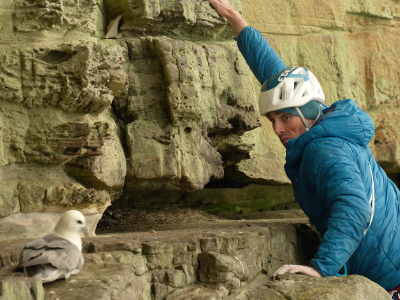Friday 28th April 2023, 1:44pm
Top Scottish climber and adventurer, Robbie Phillips, looks back at an attempt of The Longhope Direct during an early Fulmar nesting season.
Adapted from an article in Scottish Mountaineer, Issue 98 (Winter 2023)

Climbing during the nesting season is not something any climber should want to do. First and foremost, itís not good for the birds, but itís not good for the climber either! Certain birds can be aggressive towards climbers and, on sea cliffs especially, the quantity of guano can make climbing a rock face a lot less enjoyable, even the hardiest of climbers.
In 2021, I attempted The Longhope Direct (E10 7a), St Johnís Head, on the Isle of Hoy. It was June, which we assumed would be okay, but when we attempted our ground-up push, it became very quickly apparent that the Fulmars had been nesting and started laying the yearís eggs already.
We did our best to avoid the nests but on one of the upper pitches, I had no option but to mantle onto a ledge beside a Fulmar and her egg. She sat there peacefully beside me - occasionally staring up at me with her beady little eyes - and not showing much issue with my presence, that was, until my partner Emma joined us, and she flew off, leaving her egg. We suddenly felt an enormous pang of guilt and Emma quickly scooted up the very short 15m pitch so we could get off the ledge. As I belayed Emma, I saw the mother fulmar flying back to the egg, but too scared to land, she kept turning and flying away again.
Emma shouted from above that it was safe but, as I started to climb, I turned back in hope of seeing the mother and instead saw a big, fat seagull trying to get the egg!
ďGET LOST!Ē I shouted, managing to shoo the predator away.
I waited a few minutes, guarding the nest from a couple metres away, until the mother returned and sat back on the egg.
Before you call me out for being selfish, let me just sayÖ. yep, I was! I put myself before the birds. I thought I could avoid the nests and, in doing so, I put a beautiful little Fulmar baby at risk. In fact, I still donít know if that chick was okay. The mother was gone for 20 minutes, maybe the incubation of the embryo was affected? I still feel terrible about it even now, over a year and half later.
I climbed only 30 metres more to another ledge - which this time was home to six Fulmars and their eggs - and I realised there was no way, with good conscious, I could continue.
I shouted to Emma: ďIím done! Weíre done! I canít continue. Letís bail!Ē
ďYeah, youíre right. Letís go.Ē Emma replied.
The following year, I returned to Hoy in early May, on recommendation from my friend Benjy Wilcock; a naturalist, bird tagger and ex-RSPB staff member (who, handily, also happened to do his university thesis on Fulmars). He was spot on! The Fulmars were mating, but they hadnít built their nests or laid any eggs. As well as that, they were noticeably less aggressive!
Being a climber is about a lot more than climbing rocks - itís also a wonderful opportunity to access remote parts of the world rarely seen by other humans. As a result, these spaces are home to a myriad of wildlife, including birds. Climbing provides an incredible chance to share spaces and get close to these creatures but, most importantly, only on their terms. At the end of the day, weíre only ever passing through, and these places are their home.
So, what can you do? Try to educate yourself on nesting birds at crags and other areas before you head out to climb (Mountaineering Scotland have comprehensive advice for climbers on avoiding bird disturbance and the latest bird nesting updates, available at: www.mountaineering.scot/access/birds-and-nesting).
Be observant from the second you arrive at the crag and use common sense. If you see a lot of bird activity around a ledge, maybe avoid it. Birds donít tend to nest on overhangs or flat faces, they generally like ledges.
And, if all the above fails and you accidentally come face-to-face with a nest, just back off - no climb is worth the life of a baby chick.
Visit: www.robbieclimbs.com to see Robbieís latest speaking tour dates.